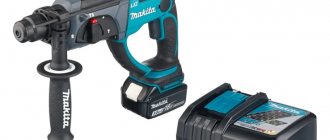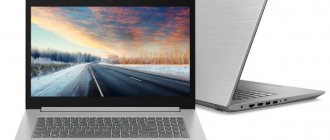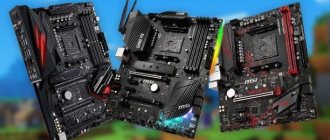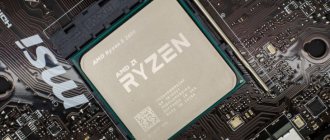Tips for choosing RAM
For many users at the moment, the optimal value is 16 GB of RAM. Over time, programs grow in size and become more complex, 1080p and even 4K video is becoming more common, the size of computer games is increasing, and websites are also becoming more complex. When multitasking, advanced users may need 32 GB of memory to avoid using significantly slower virtual memory from disk. However, this is expensive, while 16 GB should be enough for gaming and work.
The RAM speed stated as part of the XMP profile may not be achievable on motherboards for AMD processors. XMP can be considered as automatic memory overclocking, which was developed for Intel motherboards. Some motherboards offer BIOS settings to achieve higher frequencies on motherboards with AMD processors. Unfortunately, these settings are not available on all boards, and even if they are, they do not always work.
Want the fastest memory on the Intel platform? Take K-series processors. Core i9, Core i7 and Core i5 processors without K are limited to DDR4-2933, which is specified in Intel H470 and B460 chipsets. Core i3s have an even lower memory limit of DDR4-2666. Most motherboards don't have XMP, and if they do, it will be easier to configure the memory with better timings. You just need to keep in mind that these rules have changed with the latest Intel Rocket Lake processors. Memory overclocking is now available on motherboards based on H570 and B550 chipsets.
Always buy one set of memory with the capacity you need. Never combine two memory modules or sets, even if they are from the same manufacturer and model. This does not always give the desired result and manual adjustment may be required to achieve stable operation.
If you want to install memory and forget about it, choose a kit with officially supported processor clock speeds. For example, DDR4-3200 is the minimum requirement for AMD Ryzen 5000 processor and Intel 11th generation Rocket Lake processors. For the latter, only the Core i9 models support DDR4-3200 memory on the Gear 1. The remaining Rocket Lake chips work with DDR4-2933 on the Gear 1 and DDR4-3200 on the Gear 2.
Game testing results
Assassin's Creed Origins
The game is known for being very processor intensive.
Actually, this can be seen from the results obtained, especially with an Intel processor and, first of all, with FullHD resolution. The difference between the “base” frequency of 2133 MHz and the maximum 4000 MHz was 10-11%, depending on the graphics settings. When switching to a higher resolution, the difference in the number of FPS decreases to 2-4%.
AMD Ryzen was less responsive to changes in RAM speed. The maximum effect from using faster memory in FullHD resolution was 6%.
Battlefield 1
In this game, when using an Intel processor at medium graphics settings in FullHD resolution, the video card reaches a maximum of 200 FPS and is practically independent of the speed of the RAM. The same picture in higher resolution. There is no point in fast memory in this case.
The situation is different for AMD. The dependence on memory speed is obvious, and reaches 12-15% depending on graphics settings in FullHD resolution. With ultra settings in WQHD resolution, differences in memory speed are much less noticeable, with the slowest set of RAM losing the most. Starting from the frequency of 2666 MHz, the differences fit into percentages.
F1 2017
Racing simulators, as a rule, depend less on the video card, but on the performance of the processor, memory, etc. pay much more attention. The results confirm this.
For Intel, the difference between the slowest and fastest RAM kit was 21% at medium graphics settings in FullHD. Switching to ultra settings reduced this result by almost half. At WQHD resolution, using the fastest memory can result in a 9% and 3% increase in FPS for medium and ultra graphics settings, respectively.
With AMD the situation is different again. Using faster memory compared to the slowest DDR4-2133 brings an effect of about 12-15% at all resolutions and any graphics settings. Moreover, most of the increase is observed when moving from DDR4-2133 to DDR4-2933. Then the results also grow, but very slowly.
GTA V
The game is known for its processor dependence and willingness to “use” all available resources. This was reflected in the results.
In the case of the Core i7 8700K, the increase in FPS depends on the graphics settings; the higher it is, the more justified is the use of high-frequency RAM. The maximum effect at FullHD resolution on ultra settings is 16%. This is most evident when switching to memory with a frequency of 3200 MHz. Further increasing the frequency gives a less noticeable effect.
AMD shows the same stability as in the case of F1 2021. Regardless of the settings, switching to higher frequency memory will bring plus 12-14% fps. You can see that the effect is noticeable up to a frequency of 3200 MHz. There is almost no point in further increase.
Rainbow Six Siege
The game is very popular among eSports players, and therefore the number of FPS is a very important parameter.
For Intel CPUs, the greatest effect from high-speed memory is manifested at FullHD resolution and average “picture” settings - 5%. Moreover, at a RAM frequency of 3200 MHz, almost a maximum of 333 FPS is achieved, and further increasing the memory speed has no effect.
With ultra settings or when switching to WQHD, the effect of RAM performance is within a maximum of a couple of percent.
The AMD CPU is more sensitive to changes in memory operating mode, and this is most noticeable at medium graphics settings. As image quality improves, memory dependency decreases to 3%.
Best 16GB Kit for Ryzen Processors: TeamGroup T-Force Xtreem ARGB DDR4-3600 (2 x 8GB)
- Model: TF10D416G3600HC14CDC01.
- Volume: 16 GB (2 x 8 GB).
- Data transfer rate: DDR4-3600 (XMP).
- Timings: 14-15-15-35 (2T).
- Voltage: 1.45 V.
- Warranty: lifetime.
pros
- Excellent performance.
- Attractive appearance.
- Good acceleration.
- The cheapest kit in its category.
Minuses
- Difficult to find on sale.
TeamGroup did a great job with the Xtreem ARGB DDR4-3600 C14 memory, which has no weak points. The memory looks great with the backlight on and even when it's off. It works no less well. This is the fastest DDR4-3600 C14 memory kit tested so far.
DDR3 vs DDR4
DDR3 vs. DDR4
| Benchmark | Result (DDR3, 4GB, 1.333 MHz CL9) | Result (DDR4, 4GB, 2.133 MHz CL15) |
| Cinebench 15 OpenGL | 98.27 fps | 113.13 fps |
| PCMark 7 | 6.320 points | 6,443 points |
| PCMark 8 | 4,811 points | 4.817 points |
| 3DMark Cloud Gate | 13,174 points | 13.387 points |
| 3DMark Fire Strike | 3.965 points | 3.977 points |
| DiRT Rally | 26 fps | 26 fps |
| Ashes of the Singularity | 15 fps | 15 fps |
| DX11 Feature Test Single-thread | 1.105.063 Draw calls | 1.427.945 Draw calls |
| DX12 Feature Test | 7.645.525 Draw calls | 8.142.534 Draw calls |
Best High Speed 16GB Kit: Patriot Viper Steel DDR4-4400 (2 x 8GB)
- Model: PVS416G440C9K.
- Volume: 16 GB (2 x 8 GB).
- Data transfer rate: DDR4-4400 (XMP).
- Timings: 19-19-19-39 (2T).
- Voltage: 1.45 V.
- Warranty: lifetime.
pros
- Excellent timings DDR4-4400 (19-19-19-39).
- Outperforms competing DDR4-4600 kits.
- Moderate cost.
- Design without backlight.
Minuses
- More expensive than analogues in terms of performance with backlight.
- To get the best XMP profiles, you need to choose your motherboards specifically.
If you have a motherboard that can handle top speeds and games and other applications where those speeds are in demand, the Patriot Viper Steel DDR4-4400 16GB is a great non-backlit purchase.
By making the trims as simple as possible, the Viper Steel has the best timings, which significantly improves performance in certain programs and games. Competition in the market for gaming computers and specialized assemblies for solving specific problems remains high, and the Viper Steel DDR4-4400 occupies its niche in this segment.
Prices for Yandex.Market
Best High Speed 16GB RGB Kit: Patriot Viper RGB DDR4-3600 (2 x 8GB)
- Model: PVR416G360C6K.
- Volume: 16 GB (2 x 8 GB).
- Data transfer rate: DDR4-3600 (XMP).
- Timings: 16-18-18-36 (2T).
- Voltage: 1.35 V.
- Warranty: lifetime.
pros
- XMP timings on DDR4-3600.
- Overclocking capability.
- Excellent timing settings.
- Compatible with motherboard backlight software.
- Free Patriot RGB Software.
Minuses
- LED diffuser causes colors to merge or bleed.
This manufacturer decided not to pursue external beauty. Instead, a clock speed of up to 4133 MHz is given. The DDR4-3600 kit costs just $10 more than the white LED version and is cheaper than competitors with similar latency. This increases its value at similar speeds, although slower kits can be found for less.
The Patriot Viper RGB DDR4-3600 is the fastest DDR4-3600 kit tested. This is a great buy for those who want LED lighting and high overclocking potential.
Prices for Yandex.Market
System under test
| The product's name | Category | price, rub. |
| Palit GeForce GTX 750 Ti KalmX 2GB | Graphics card | 9500 |
| Intel Core i3-6100 | CPU | 8900 |
| Gigabyte GA H110M-DS2 DDR4 | Motherboard (DDR4) | 3800 |
| Gigabyte GA H110M-DS2 DDR3 | Motherboard (DDR3) | 3800 |
| Seasonic S12II-430 Bronze | power unit | 3800 |
| Toshiba Q300 120GB | SSD storage | 3350 |
| Zalman T3 Mini | Frame | 1750 |
| Windows 10 Pro 64Bit | operating system | 2700 |
| Kingston VALUERAM 4GB DDR4-2133 | DDR4 memory | 1400 |
| Samsung PC3-10600U 4GB DDR3-1.333 | DDR3 memory | 1900 |
In theory, our DDR3 memory stick with its short timings, despite the lower clock speed, should be slightly faster than DDR4. As it turned out, in this case, the type of memory will have almost no effect on games: the results of both synthetic benchmarks (3DMark) and calculation of the image refresh rate in the game turned out to be almost the same. There are slight differences in system tests (PCMark). Cinebench 15 showed an increase of about 15 fps when using DDR4.
Best 16GB Overclocking Kit: Patriot Viper 4 DDR4-3400 (2 x 8GB)
- Model: PV416G340C6K.
- Volume: 16 GB (2 x 8 GB).
- Data transfer rate: DDR4-3400 (XMP).
- Timings: 16-18-18-36 (2T).
- Voltage: 1.35 V.
- Warranty: lifetime.
pros
- The best overclocking among mid-priced kits with two sticks with a total capacity of 16 GB.
Minuses
- More expensive than budget kits.
There is no programmable LED lighting here, there are faster kits at higher prices and slower ones at lower prices. If you're someone who doesn't need rainbow-colored memory, the DDR4-3400 C16 16GB (PV416G340C6K) is a good value for money.
The kit includes two 8 GB modules with XMP DDR4-3400 CAS 16-18-18-36 values. The last three numbers aren't great, but DDR3 memory fans should remember that 16 cycles at 3400 MHz has the same latency as 8 cycles at 1700 MHz. This memory overclocks well and contains several beautiful red heatsinks, so you can’t call it nondescript.
Best 32GB RGB Kit: Corsair Vengeance RGB Pro DDR4-3200 (4 x 8GB)
- Model: CMW32GX4M4C3200C.
- Volume: 32 GB (4 x 8 GB).
- Data transfer rate: DDR4-3200 (XMP).
- Timings: 16-18-18-36 (2T).
- Voltage: 1.35 V.
- Warranty: lifetime.
pros
- Excellent performance at nominal XMP values and at different frequencies.
- Supports Corsair's own RGB utility and third-party programs.
- Low price.
Minuses
- Doesn't reach DDR4-4000.
- White diffusers cast pastel tones.
When you want to build a beautiful computer, you have to choose between aesthetics and performance. The Vengeance RGB DDR4-3200 kit offers both, namely four 8 GB DIMMs (32 GB total) with CAS 16 timing, at a reasonable price. Performance here is at a decent level.
All this makes this memory one of the best choices among RGB-backlit offerings, although not everyone will like its colors.
This kit surpasses the previously one of the best HyperX Predator RGB in speed at any frequency, not counting the unattainable DDR4-4000.
Prices for Yandex.Market
CMW32GX4M4C3200C
⇡#The world will never be the same: new architecture and topology of DDR4
At one time, during the transition from DDR2 to DDR3 memory, the developers of a new standard at that time took a revolutionary step. The typical DDR2 “star” memory bus connection topology has been replaced by a network (Fly-by) topology of command, address and control buses, with on-module (On-DIMM) termination and precision external resistors (ZQ resistors) in the calibration circuits.
However, no matter how much the rope twists, the bus with a multipoint topology of data transmission lines still comes to an end, as it did a long time ago for GDDR graphics memory. The speeds are not the same today, the requirements for the volume of transmitted data are not the same.
As Bill Gervasi unequivocally put it on this matter, “ Multi-drop bus must die .” In relation to the DDR4 standard, this means that point-to-point connections will take the place of the multipoint topology, otherwise significant performance gains will not be achieved.
It follows that the DDR4 memory subsystem will only support one single memory module per channel. It is unlikely that this will have a significant impact on the mobile and desktop PC markets, although increasing the amount of RAM will not hurt anyone, but this issue will be most important for the server market. How to increase the amount of memory under such strict channel restrictions?
Several ways out of the situation have been invented today.
The first is the most logical: it is necessary to increase the capacity of the actual chips and memory modules. One of the promising methods is the production of multi-tier chips using TSV (Through-Silicon Via) technology, which is also called “volumetric”, or simply 3D.
TSV technology has only a distant similarity with multilayer (MLP) flash memory chips, but this analogy helps to understand the essence of chip formation in the most general terms. The idea, by the way, is by no means new, since back in 2007, Samsung Electronics announced the release of the first multi-tier 512-Mbit DRAM chips using TSV technology.
It is this technology that the consortium of Elpida Memory, Powertech Technology and United Microelectronics (UMC) plans to use to release DDR4. Together, they intend to develop TSV (Through-Silicon Via) technology to produce multilayer 3D chips that combine logic and memory. The project will develop technology for the production of multilayer chips for the 28-nm process technology based on DRAM technologies from Elpida, PTI assembly plants and UMC logic production facilities. Thus, it is planned to achieve the release of relatively inexpensive DDR4 memory chips with very high capacity.
Hynix is also actively working on the implementation of TSV technology, and at Denali MemCon10 they spoke about their own plans to produce high-capacity DDR and GDDR chips for the coming years. According to company representatives, the development of techniques for using TSV is currently in its infancy, and it is difficult to assess what benefits this may bring in the future.
Another well-known and already proven method is the use of the so-called “unloading memory” technique - LR-DIMM (Load-Reduce DIMM). The essence of the idea is that the LR-DIMM memory module includes a special chip (or several chips) that buffers all bus signals and allows you to increase the amount of memory supported by the system.
For example, today Samsung and Micron have already mastered the technology of producing DDR3 LR-DIMM memory modules with a capacity of 32 GB. Nothing limits the use of this technology when releasing DDR4 memory. True, we should not forget about perhaps the only, but no less significant, drawback of LR-DIMMs: buffering inevitably leads to an additional increase in latency, which for DDR4 memory, by definition, will already be rather large.
For the server and high-end computing segment, where a very large amount of memory is in demand, a completely different way out of the situation is proposed. It assumes the use of high-speed switching with special multi-input switch chips.
As is known, the CAS latency (the delay between sending a column address to memory and the start of data transfer) of current DDR3 memory is 5 - 16 clock cycles, for GDDR5, respectively, 5 - 36 clock cycles; while tRFC for DDR3 is 90 – 350 ns. In particular, for DDR3-2133 memory, typical timings are 12-12-12 versus 9-9-9 for many DDR3-1333 modules. Unfortunately, we cannot yet estimate the timings and latency of DDR4 memory even theoretically, because, let me remind you, the release of the final DDR4 specifications is planned by JEDEC no earlier than 2012. The 8n prefetch buffer, designed to fetch 8 words of data per memory access in DDR3, will indeed replace Prefetch16 in DDR4, but it is difficult to assess exactly how this will affect overall performance without knowing the other key characteristics of DDR4.
Best Dual 32GB DIMM Kit: Patriot Viper Steel DDR4-3200 (2 x 16GB)
- Model: PVS432G320C6K.
- Volume: 32 GB (2 x 16 GB).
- Data transfer rate: DDR4-3400 (XMP).
- Timings: 15-15-15-36.
- Voltage: 1.35 V.
- Warranty: lifetime.
pros
- Very inexpensive DDR4-3200 memory.
- Competitive performance.
- No backlight.
Minuses
- For some, the lack of backlight will be a disadvantage.
Those who want to get a productive computer have only two reasons for choosing DDR4-3200: an attempt to save money or working with a system where more advanced memory is not supported.
Although the performance advantage of this memory does not exceed 1%, the price is significantly lower than competing products. As a result, in terms of price and features, this is the best choice.
Prices for Yandex.Market
Quad-channel DDR4 memory kits with a total capacity of 16 GB
The range of available DDR4 memory on the market is gradually increasing. To date, this memory is compatible only with motherboards based on the Intel X99 chipset and, accordingly, processors codenamed Haswell-E (LGA2011-v3 socket). Actually, the fact that DDR4 memory is compatible only with the specified Intel platform already means that it is intended for the most powerful PCs today. All Intel X99 chipset motherboards support up to 64 GB of DDR4 memory in quad-channel mode (assuming the board has eight memory slots). Let’s immediately make a reservation that we are talking about non-register (UDIMM) non-ECC memory. The fact is that some boards with the Intel X99 chipset support server processors of the Intel Xeon E5 v.3 family (having the same LGA2011-v3 socket and the same processor architecture). In this case, ECC memory is supported, both registered (RDIMM) and non-registered (UDIMM), and the maximum memory capacity is already 128 GB. However, we will not consider server memory in this article, and in the future, by DDR4 memory we will mean non-register memory without ECC.
As for the capacity of DDR4 memory modules, modules with a capacity of 4 GB (these are the most common) and 8 GB are available on sale. DDR4 memory is sold both in the form of individual modules and in the form of kits consisting of two, four and even eight modules. But the most common are sets of four memory modules (quad-channel sets). Accordingly, the total capacity of such a kit can be either 16 or 32 GB. The most common on the market today are four-channel memory sets with a total capacity of 16 GB, that is, sets of four memory modules with a capacity of each module of 4 GB.
The minimum DDR4 memory frequency required by the standard is 1066 MHz. Accordingly, the effective frequency in this case is 2133 MHz (DDR4-2133 memory), and the bandwidth is 17056 MB/s (in single-channel mode). The maximum memory frequency provided by the standard is 2133 MHz, its effective frequency in this case is 4266 MHz (DDR4-4266 memory), and the bandwidth is 34128 MB/s (in single-channel mode). True, the frequency of 2133/4266 MHz is a reserve for the future, while such memory is not on sale. In fact, today on the market there is memory with an effective frequency from 2133 MHz to 3000 MHz, and it seems that only DDR4-2133 memory is standardized, and faster memory is implemented through XMP profiles.
As a rule, more expensive and faster DDR4 memory modules are equipped with heatsinks that serve no purpose other than attracting the attention of users. Heatsinks on memory modules are purely decorative and, by and large, pointless, since memory chips simply don’t get hot enough to require cooling using heatsinks. Let's not be unfounded and confirm what has been said with facts. In order to demonstrate the pointlessness of heatsinks on memory modules, we used a pyrometer that allows us to remotely determine temperature changes. For the test, we used a DDR4-2133 (15-15-15) memory module without a heatsink, the supply voltage was 1.2 V. In idle mode, the temperature of the memory chips was 31.2 °C, and when loading the memory using the Stress System stress test Memory in the AIDA64 utility, the temperature of the memory chips increased to 35.5 °C. When overclocking the same memory to a frequency of 2400 MHz and a supply voltage of 1.35 V, the temperature of the memory chips in idle mode was 32.7 °C, and when the memory was loaded it increased to 38.1 °C. It is clear that at such temperatures there is simply no point in radiators. Additionally, all 4GB DDR4 memory modules are single-sided, meaning the memory chips are located on one side of the module. It would seem that if you glue the radiator, then only on one side. However, heatsinks on such memory modules are always on both sides - it’s just prettier that way.
Now about the cost. As a first approximation, DDR4 memory costs approximately 1 thousand rubles per 1 GB. That is, a memory module with a capacity of 4 GB costs approximately 4 thousand rubles, and a memory module with a capacity of 8 GB costs 8 thousand rubles. However, you need to keep in mind that decorative heatsinks and higher declared operating frequencies lead to an increase in the cost of memory. That is, a DDR4-3000 memory module will be more expensive than a DDR4-2133 memory module (with equal capacity).
Next, we will look at five four-channel DDR4 memory kits with a total capacity of 16 GB. Let's start with a more detailed acquaintance with the participants of our testing.
AMD Radeon R7 Performance Series (R744G2133U1S)
As strange as it may seem, AMD produces DDR4 memory sets that are currently compatible only with Intel processors. However, AMD’s website is modestly silent about this, and therefore it is not possible to find any technical information about DDR4 memory there. Apparently, pride does not allow this fact to be made public, but the company does not want to give up making money.
According to the information we have, AMD currently offers two four-channel DDR4 memory kits, which differ only in capacity: these are sets of four modules with a total capacity of 32 GB (R748G2133U2S) and sets of four modules with a total capacity of 16 GB (R744G2133U1S). For both kits, the memory frequency is 2133 MHz, and the timings are 15-15-15-36.
Next, we will look at a memory kit of four modules with a total capacity of 16 GB (R744G2133U1S), which belongs to the AMD Radeon R7 Performance series. As already noted, AMD R744G2133U1S memory modules have a frequency of 2133 MHz and timings of 15-15-15-36, and the supply voltage is 1.2 V (this is the standard value).
The declared memory frequency is low (this is the minimum value for DDR4), but there is a high probability that this memory can be made to operate at a higher frequency.
Memory modules are equipped with dark gray cooling radiators, which are two metal plates glued to each side of the module. Moreover, the modules themselves are single-sided, that is, the memory chips are located on only one side.
On our test bench with the default settings in the UEFI BIOS, the AMD Radeon R7 Performance Series (R744G2133U1S) memory started up at a frequency of 2133 MHz with timings of 15-15-15-36, that is, exactly as it should be.
In addition, it turned out that the memory can operate at a frequency of 2400 MHz. When the memory is launched at this frequency, the timings are automatically set to 18-18-18-40, however, at a frequency of 2400 MHz, this memory can also work with timings 18-11-11-36.
The following are the test results in the AIDA64 program for a set of AMD Radeon R7 Performance Series memory modules (R744G2133U1S) with default settings (DDR4-2133; 15-15-15-36) and overclocked (DDR4-2400; 18-11-11- 36).
Geil Evo Potenza GPR416GB3000C16QC
The Geil GPR416GB3000C16QC quad-channel memory kit belongs to the Geil Evo Potenza series. These are four DDR4-3000 memory modules with a total capacity of 16 GB (4 × 4 GB). The memory modules are equipped with burgundy-colored cooling radiators. The memory modules themselves are single-sided, that is, all memory chips are located on one side. In general, it should be noted that the radiators in the memory, let’s say, do not look impressive. The thickness of the plates from which the radiator is made is less than 1 mm. The height of the memory module with radiator is 47 mm.
According to information on the manufacturer’s website, at a frequency of 3000 MHz, Geil Evo Potenza GPR416GB3000C16QC memory modules can operate with timings of 16-16-16-36 with a supply voltage of 1.35 V. Moreover, this mode of operation of memory modules is ensured when the XMP profile is activated.
Note that the Geil Evo Potenza series of Quad Channel memory also includes DDR4-2133/2400/2666/2800 memory kits, as well as faster DDR4-3200 memory. Geil Evo Potenza DDR4-3000 quad-channel memory kits can also be different: so, in addition to 16 GB kits, there are also kits with a total capacity of 32 GB. Memory timings may also differ: 15-15-15-35 or 16-16-16-36. Taking into account two possible capacities and two sets of timings, the Geil Evo Potenza DDR4-3000 series includes four sets of memory:
- GPR416GB3000C15QC: timings 15-15-15-35, total volume 16 GB;
- GPR416GB3000C16QC: timings 16-16-16-36, total volume 16 GB
- GPR432GB3000C15QC: timings 15-15-15-35, total volume 32 GB;
- GPR432GB3000C16QC: timings 16-16-16-36, total volume 32 GB.
Now let's talk about the difficulties we encountered when testing the Geil Evo Potenza GPR416GB3000C16QC memory.
First of all, we note that the declared frequency of 3000 MHz with timings 16-16-16-36 and a supply voltage of 1.35 V are the characteristics of the XMP profile. And, of course, it is not a fact that this profile will work on any board and that the memory will even “start up” at this frequency. As practice shows, there are boards based on the Intel X99 chipset that, with the default UEFI BIOS settings, try to immediately activate the XMP profile and make the memory work with the specified characteristics. With such boards, this memory kit will have big problems and, most likely, it simply will not work. In particular, we tested this memory kit on three boards (Gigabyte GA X99-Gaming G1 WIFI, Asus Rampage V Extreme and ASRock Fatal1ty X99X Killer) and it turned out that the ASRock Fatal1ty X99X Killer board is not compatible with this memory at all.
But on the Gigabyte GA X99-Gaming G1 WIFI and Asus Rampage V Extreme boards with default UEFI BIOS settings, the Geil Evo Potenza GPR416GB3000C16QC memory was detected differently.
So, in the case of the Asus Rampage V Extreme board, the Geil Evo Potenza GPR416GB3000C16QC memory kit is defined as DDR4-2400 with timings 17-15-15-35 (supply voltage 1.2 V).
In the case of the Gigabyte GA X99-Gaming G1 WIFI board, the same memory kit was defined as DDR4-2400, but with timings of 16-16-16-35.
Now about the most important thing. On none of our test boards was the Geil Evo Potenza GPR416GB3000C16QC memory able to work with the settings defined in the XMP profile, that is, at an effective frequency of 3000 MHz with timings of 16-16-16-36 and a supply voltage of 1.35 V. If If you manually set the UEFI BIOS to a frequency of 3000 MHz, timings of 16-16-16-36 and a supply voltage of 1.35 V, the system will not boot. We also tried to roughen up the timings for 3000 MHz, but it was all in vain. At this frequency the memory refused to work.
Through trial and error, it was found that our Geil Evo Potenza GPR416GB3000C16QC memory kit can operate at a maximum frequency of 2666 MHz, no higher. In fact, the declared frequency of 3000 MHz turned out to be simply a hoax. However, we will not make such loud statements at all and will clarify that our specific Geil Evo Potenza GPR416GB3000C16QC memory kit with our specific Intel Core i7-5960X processor and our Gigabyte GA X99-Gaming G1 WIFI board does not meet the declared characteristics.
For 2666 MHz the best timings we could find were: 13-14-14-30. With such timings at a frequency of 2667 MHz, everything works stably, without freezing.
The following are the test results in the AIDA64 program for a set of Geil Evo Potenza GPR416GB3000C16QC memory modules with default settings (DDR4-2400; 16-16-16-35) and overclocked (DDR4-2667; 13-14-14-30).
Kingston HyperX Predator HX424C12PBK4/16
Kingston HyperX Predator HX424C12PBK4/16 memory belongs to the Kingston HyperX Predator overclocker memory series.
As follows from the information on the manufacturer’s website, the company produces a very wide range of DDR4 memory kits. The capacity of the kits can be 16, 32 and 64 GB, the number of modules in one kit can be four or eight, and the capacity of one module can be 4 or 8 GB. At the same time, the company produces DDR4 memory kits with effective frequencies of 2133, 2400, 2666, 2800 and 3000 MHz.
The Kingston website contains information to decipher the name of the memory module. Using this information, you can understand that the name of the HX424C12PBK4/16 module encrypts the following information: this is a UDIMM DDR4-2400 memory module with CAS 12 latency. The memory belongs to the HyperX Predator series, is equipped with a black heatsink, and the total capacity of the set of four modules is 16 GB.
On our test bench with default UEFI BIOS settings, the Kingston HyperX Predator HX424C12PBK4/16 memory started up at 2133 MHz with timings of 15-15-15-36 and a supply voltage of 1.2 V.
The promised frequency of 2400 MHz with timings 12-13-13-35 is implemented through the XMP profile. Moreover, for the Kingston HyperX Predator HX424C12PBK4/16 memory there are two XMP profiles: one for a frequency of 2400 MHz with timings 12-13-13-35 at a supply voltage of 1.4 V, and the second? for a frequency of 2133 MHz, but with timings 13-13-13-36 and a supply voltage of 1.2 V.
When the first XMP profile is activated in the UEFI BIOS (for a frequency of 2400 MHz), the memory, as it should, starts at a frequency of 2400 MHz with timings of 12-13-13-35 at a supply voltage of 1.4 V. However, manually for a frequency of 2400 MHz You can also select shorter timings. In particular, on our test bench the memory worked with timings of 12-12-12-35 (at a frequency of 2400 MHz).
But we were unable to run the Kingston HyperX Predator HX424C12PBK4/16 memory at a higher frequency (2600 MHz), even with coarser timings.
The following are the test results of a set of Kingston HyperX Predator HX424C12PBK4/16 memory modules at a frequency of 2133 MHz (15-15-15-36) and 2400 MHz (12-12-12-35) in the AIDA64 program.
AData XPG AX4U2400W4G16-QRZ
AData produces DDR4 memory in two series: Consumer (user) and Gaming (game). There is also server memory, but we are not considering it now. The AData XPG AX4U2400W4G16-QRZ memory kit belongs to the Gaming series.
In this case, you should not take the word Gaming seriously. This is just a marketing positioning of memory, which is aimed at attracting attention. The Gaming series memory differs from the regular Consumer series in the presence of decorative radiators (the radiators have no other meaning) and in the fact that the Gaming series memory is faster.
The AData Gaming series offers a very large number of different memory kits. Moreover, any AData Gaming series memory module can be purchased separately (one module), in a set of two modules, or in a set of four modules. In addition, both 4GB and 8GB modules are available. This is precisely why the range of possible AData Gaming DDR4 memory kits is very wide.
However, it is not difficult to understand this assortment. There is DDR4-2133 memory with timings of 13-13-13 and 15-15-15. Taking into account the possible capacity of the modules (4 and 8 GB), as well as the different configurations of the sets (one, two and four modules), we find that there are twelve options for DDR4-2133 memory alone.
Further, there is DDR4-2400 memory with timings 16-16-16, DDR4-2666 memory with timings 16-16-16, DDR4-2800 memory with timings 17-17-17 and DDR4-3000 memory with timings 16-16-16 . Again, any memory can be represented in sets of one, two or four modules, and the module capacity can be 4 or 8 GB.
There is also faster DDR4-3200/3300/3333 memory. But for this memory the timings are only 16-16-16, and the modules have a capacity of 4 GB.
Next, we will look at a set of four AData XPG AX4U2400W4G16-QRZ memory modules. As you can easily guess from the name, we are talking about DDR4-2400 memory modules with 16-16-16 timings. The supply voltage of these memory modules is 1.2 V.
On our test bench with default UEFI BIOS settings, the AData XPG AX4U2400W4G16-QRZ memory started up at 2133 MHz with timings of 15-15-15-36 and a supply voltage of 1.2 V.
The promised frequency of 2400 MHz with timings of 16-16-16 is implemented through the XMP profile.
When the XMP profile is activated in the UEFI BIOS, the memory, as it should, starts at 2400 MHz with timings of 16-16-16-39.
We were unable to run the AData XPG AX4U2400W4G16-QRZ memory at a higher frequency. However, at a frequency of 2400 MHz, better timings can be selected. The best timings that we were able to find for this memory at a frequency of 2400 MHz were 13-12-12-36.
Below are the test results of a set of AData AD4U2133W8G15-B memory modules at a frequency of 2133 MHz (15-15-15-36) and 2400 MHz (13-12-12-36) in the AIDA64 program.
AData AD4U2133W4G15-B
If the previous AData kit belonged to the gaming series, then the AData AD4U2133W4G15-B memory kit belongs to the Consumer series, that is, to the simplest series of DDR4 memory.
The Consumer series includes two types of DDR4-2133 memory modules: 4 GB and 8 GB. In the first case, the modules are called AData AD4U2133W4G15-B, and in the second - AData AD4U2133W8G15-B. All other characteristics of the modules are absolutely the same. The effective memory frequency is 2133 MHz, timings are 15-15-15-36, and the supply voltage is 1.2 V. Memory modules with a capacity of 4 GB are single-sided and are based on SKhynix H5AN4G8NMFR memory chips (8 chips of 512 MB each).
Note that there are no heatsinks on the AData AD4U2133W8G15-B memory modules.
On our test bench with default UEFI BIOS settings, the AData AD4U2133W8G15-B memory started up without problems in full compliance with the specification, that is, at a frequency of 2133 MHz with timings of 15-15-15-36 and with a supply voltage of 1.2 V.
Moreover, it turned out that this memory can operate at a frequency of 2400 MHz. When setting this frequency, the timings in automatic mode are set to 16-17-17-40. The best timings that we were able to select for this memory without loss of stability were 14-14-14-36.
Below are the test results of a set of AData AD4U2133W8G15-B memory modules at a frequency of 2133 MHz (15-15-15-36) and 2400 MHz (14-14-14-36) in the AIDA64 program.
Testing
So, in total, five sets of four-channel DDR4 memory took part in our testing, each of which was tested in two operating modes: with default settings and with settings corresponding to maximum overclocking.
| Memory | frequency | timings | |
| AData AD4U2133W8G15-B | default | 2133 | 15-15-15-36 |
| acceleration | 2400 | 14-14-14-36 | |
| AData XPG AX4U2400W4G16-QRZ | default | 2133 | 15-15-15-36 |
| acceleration | 2400 | 13-12-12-36 | |
| Kingston HyperX Predator HX424C12PBK4/16 | default | 2133 | 15-15-15-36 |
| acceleration | 2400 | 12-12-12-35 | |
| AMD Radeon R7 Performance Series (R744G2133U1S) | default | 2133 | 15-15-15-36 |
| acceleration | 2400 | 18-11-11-36 | |
| Geil Evo Potenza GPR416GB3000C16QC | default | 2400 | 16-16-16-36 |
| acceleration | 2667 | 13-14-14-30 | |
First of all, we note that all memory kits, with the exception of Geil Evo Potenza GPR416GB3000C16QC, were defined by default as DDR4-2133 memory with timings of 15-15-15-36. In all our tests, all kits in DDR4-2133 mode with timings of 15-15-15-36 produced almost identical results. And in order not to clutter the article with unnecessary data, in the future we will simply talk about DDR4-2133 memory with timings 15-15-15-36, meaning by it any kit with default settings - with the exception of Geil Evo Potenza GPR416GB3000C16QC memory.
For testing we used a stand with the following configuration:
- Intel Core i7-5960X processor;
- Gigabyte X99-Gaming G1 WIFI motherboard;
- Intel X99 chipset;
- Intel SSD 520 Series (240 GB):
- operating system Windows 8.1 (64-bit).
Performance measurements were carried out using real applications from our test script iXBT Application Benchmark 2015. We consider the use of synthetic tests, which memory manufacturers love so much, in this case to be simply pointless, since the “parrots” they produce have nothing to do with reality.
From the iXBT Application Benchmark 2015 package, we intentionally excluded tests whose execution speed depends on the data storage subsystem (copy speed, application installation and uninstallation speed, etc.). In addition, the Adobe After Effects CC 2014.1.1 test (Test #2) was excluded. The fact is that for this test, in the case of using an 8-core (16 logical cores) Intel Core i7-5960X processor, it is advisable to use not 16, but 32 GB of memory. Otherwise, the test will be performed without multiprocessing technology, or you need to forcefully reduce the number of processor cores used. In a word, it’s easier to exclude this test, especially since the method includes another test using the Adobe After Effects CC 2014.1.1 application. In addition, we excluded tests that have a large measurement error and require a large number of repetitions to obtain a reliable result. When testing memory, when changing frequencies and timings leads to only a negligible increase in performance, it is very important to use tests in which the result has very good repeatability (with a small measurement error).
As a result, we left the following tests:
- MediaCoder x64 0.8.33.5680,
- Adobe Premiere Pro CC 2014.1,
- Adobe After Effects CC 2014.1.1,
- Photodex ProShow Producer 6.0.3410,
- Adobe Photoshop CC 2014.2.1,
- ACDSee Pro 8
- Adobe Illustrator CC 2014.1.1,
- Adobe Audition CC 2014.2,
- WinRAR 5.11, archiving,
- WinRAR 5.11, unzipping.
So, let's start with a video transcoding test using the MediaCoder x64 0.8.33.5680 application. As you can see, this task is not very sensitive to memory speed: the worst result differs from the best by only 6%. It is interesting to note that the Geil Evo Potenza memory at 2667 MHz with timings 13-14-14-30 shows the same result as the Kingston HyperX Predator memory at 2400 MHz with timings 12-12-12-35. And at 2400 MHz (with timings of 16-16-16-35), Geil Evo Potenza memory performs approximately the same as DDR4-2133 memory.
In Adobe Premiere Pro CC 2014.1 we get a similar result. The difference in test execution time between DDR4-2133 and DDR4-2400 memory is approximately 5%. And in this test, Geil Evo Potenza memory at a frequency of 2667 MHz with timings of 13-14-14-30 shows the same result as any other memory in DDR4-2400 mode. And at 2400 MHz (with timings of 16-16-16-35), Geil Evo Potenza memory performs approximately the same as DDR4-2133 memory.
In the test based on the Adobe After Effects CC 2014.1.1 application, the difference between the worst and best results is no more than 5%. Once again, Geil Evo Potenza memory at 2667 MHz with timings of 13-14-14-30 shows the same result as any other memory in DDR4-2400 mode. And at 2400 MHz (with timings of 16-16-16-35), Geil Evo Potenza memory performs approximately the same as DDR4-2133 memory.
Photodex ProShow Producer 6.0.3410 is slightly more sensitive to memory speed, and in our test the difference between worst and best results is about 6%. But again, the fastest Geil Evo Potenza memory at 2667 MHz performs the same as any other DDR4-2400 memory, and at 2400 MHz the results of Geil Evo Potenza memory are comparable to the results of DDR4-2133.
Adobe Photoshop CC 2014.2.1 turned out to be insensitive to memory speed. In our test, the difference between the worst and best results was about 3.5%. And again, the “weird” Geil Evo Potenza memory at 2667 MHz performs about the same as any other DDR4-2400 memory, and at 2400 MHz the results of the Geil Evo Potenza memory are comparable to the results of DDR4-2133.
In the test using the ACDSee Pro 8 application, the dependence on memory speed is very insignificant: the difference between the worst and best results was about 1.5%. The Geil Evo Potenza memory did not surprise us with anything pleasant: at a frequency of 2667 MHz it performs approximately the same as any other DDR4-2400 memory, and at a frequency of 2400 MHz the results of the Geil Evo Potenza memory are even slightly worse than the results of DDR4-2133.
In the test using the Adobe Illustrator CC 2014.1.1 application, nothing at all depends on memory speed. Here, for all memory sets in different operating modes, the same results are obtained.
But in the test using the Adobe Audition CC 2014.2 application, the dependence on memory speed, although insignificant, is there: the difference between the worst and best results was 4.8%. For Geil Evo Potenza memory, as in other cases, we get the following: at 2667 MHz it performs slightly worse than any other DDR4-2400 memory, and at 2400 MHz the results of Geil Evo Potenza memory are approximately the same as the results of DDR4- 2133.
In the archiving test using the WinRAR 5.11 application, the difference between the worst and best results was 5.6%. Geil Evo Potenza memory at 2667 MHz performs slightly worse than any other DDR4-2400 memory, and at 2400 MHz Geil Evo Potenza results are about the same as DDR4-2133.
In the unzipping test using the WinRAR 5.11 application, the difference between the worst and best results was 4%. And as always, Geil Evo Potenza memory at 2667 MHz shows results typical of DDR4-2400 memory, and at 2400 MHz - results typical of DDR4-2133.
conclusions
Actually, the conclusions that can be drawn from our testing are quite predictable. There is no particular point in high-speed DDR4 memory today, and the DDR4-2133 option is quite sufficient for most user applications. The maximum performance increase that can be obtained by using high-speed DDR4-2400 memory instead of standard DDR4-2133 is about 5%. Moreover, we did not find any significant difference between modules/kits from different manufacturers.
Moreover, as it turned out, high-speed memory, which is sold under the guise of DDR4-2400, is actually an overclocked version of DDR4-2133 memory, that is, the DDR4-2400 operating mode is implemented only through the XMP profile. And most likely, if you buy the most ordinary DDR4-2133 memory, you can turn it into DDR4-2400. So does it make sense to overpay?
The DDR4-3000 memory (Geil Evo Potenza GPR416GB3000C16QC) turned out to be DDR4-2400 memory, and it simply refused to work at the promised speed of 3000 MHz. In general, the Geil Evo Potenza GPR416GB3000C16QC memory is very strange. In DDR4-2667 mode (the maximum frequency at which it was able to run) it works like DDR4-2400 memory, and in DDR4-2400 mode it works like DDR4-2133 memory. Actually, this is an example for those who think that high-speed memory is cool.
As for the various oddly shaped heatsinks on high-speed memory modules, as we have already said, this is nothing more than a decorative element. Modern DDR4 memory, even with a supply voltage increased to 1.4 V, does not need radiators at all.
Best Dual DIMM 64GB Kit: Patriot Viper Steel DDR4-3600 (2 x 32GB)
- Model: PVS464G360C8K.
- Volume: 64 GB (2 x 32 GB).
- Data transfer rate: DDR4-3600 (XMP).
- Timings: 18-20-20-40 (2T).
- Voltage: 1.35 V.
- Warranty: lifetime.
pros
- Excellent performance..
- Sufficient volume for content creation.
- Great for motherboards with two memory slots.
Minuses
- Small margin of productivity increase.
The Viper Steel DDR4-3600 C18 is an excellent memory kit for content creators and professional users whose computers do not have many DDR4 memory slots. Productivity here is at a high level.
Patriot squeezes the maximum out of this memory, so there is almost no room for overclocking, even if you change the voltage. However, Viper Steel's operation at the promised frequency provides sufficient performance for most application scenarios.
Given the high performance, this kit can be recommended to users who have only two slots and who need high speed.
Prices for Yandex.Market











